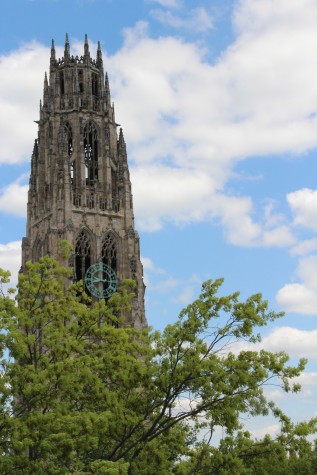Cutting Out Common App

Yale University is among the Ivy Leagues reevaluating their application processes.
The Common Application remains one of the most dreaded elements of senior year for many high schoolers across the nation. For convenience, most colleges utilize this form of application, eliminating the need to fill out duplicate forms regarding extracurriculars, community service, and the like, while essays remain original to each university. But according to the New York Times, in January 2016, over eighty colleges, including the eight Ivy Leagues and other prominent private universities, met to discuss altering the Common Application in a way that may drastically change how high school students approach college applications.
The group of eighty schools, known as the Coalition for Access, Affordability, and Success, want to complete the new online application by fall, potentially altering how the Class of 2017 and younger classes apply. The Coalition aims to diversify future student bodies and open up college campuses to lower income students.
Higher education reform to benefit more low income families is desperately needed. As of now, top tier schools are often inaccessible to lower income families, as processes such as early decision, legacy admissions, affirmative action, and athletic recruiting work against poorer students. Early decision, which gives students a higher chance of acceptance and early knowledge of their acceptance at a specific school, caters toward applicants who know they will be able to afford that school regardless of the amount of financial aid it offers. Legacy admissions favor the children of often wealthy donors to the university, and affirmative action, designed to admit more minorities, usually aids upper and middle class minority families. Even admissions based on athletic merit rely on the candidate’s income, as lower income families are often unable to fund their child’s athletic endeavors. Despite the fact that many Ivy Leagues and other top tier universities are need-blind, in which case income is not considered in the admittance process, programs such as these greatly reduce low income students’ chances of admission. As a result, “for every student from the entire bottom half of the nation’s income distribution at Dartmouth, Penn, Princeton, Yale and more than a few other colleges, there appear to be roughly two students from just the top 5 percent (which means they come from families making at least $200,000),” as David Leonhardt of the New York Times noted.
These universities are also considering having students begin applications from as early as freshman year. Students would fill a “locker” with creative works that they would eventually submit for colleges to view. This premise would certainly impact each individual student differently. Wilcox 11th grader Wesley Tong shared his interest in the new form of application, speculating that it would help colleges discover more well-rounded applicants. “It dispels the notion that certain years are more important than others, or that some are obsolete,” Tong commended. However, both Tong and 11th grader Brandon Tran expressed their concern about the stress this application could put on overwhelmed high school students. “High schoolers should have the ability to enjoy their time without college looming overhead,” mourned Tran. As Frank Bruni of the New York Times put it, this “frenzied, freaked-out world of college admissions” could certainly see a push for younger students to aim higher. Additionally, the creative element of this application could stand to benefit some students and harm others. For some high schoolers, this portfolio may exhibit their linguistic prowess and development, while the STEM-inclined could suffer.
The question on many higher education experts’ minds remains: how does the “locker” help low income applicants? Bruni, himself, feels it simply does not. Many low income students may never have the knowledge or opportunity to use the program at all, making the Coalition’s plan obsolete. This plan would require a massive amount of mentors to guide students through the process of application. Instead, Bruni fears the new application could simply become reason for privileged families to further pressure their children about college and careers.
The Common Application is far from flawless, but it remains to be seen whether its replacement will help or harm college-bound children across America in their future endeavors.





